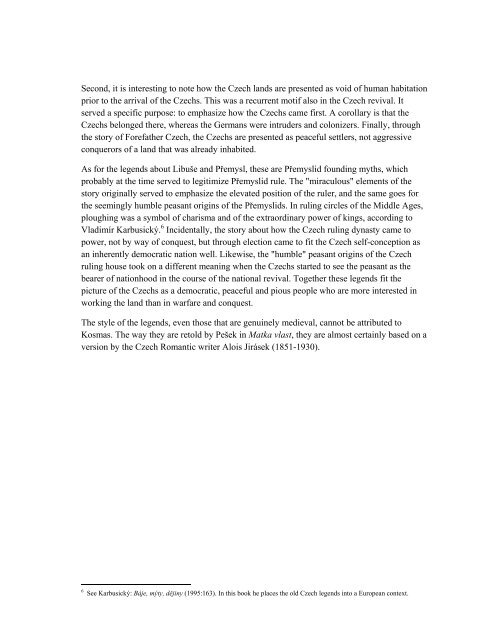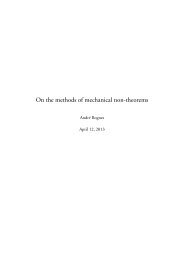Appendixes A-D
Appendixes A-D
Appendixes A-D
You also want an ePaper? Increase the reach of your titles
YUMPU automatically turns print PDFs into web optimized ePapers that Google loves.
Second, it is interesting to note how the Czech lands are presented as void of human habitation<br />
prior to the arrival of the Czechs. This was a recurrent motif also in the Czech revival. It<br />
served a specific purpose: to emphasize how the Czechs came first. A corollary is that the<br />
Czechs belonged there, whereas the Germans were intruders and colonizers. Finally, through<br />
the story of Forefather Czech, the Czechs are presented as peaceful settlers, not aggressive<br />
conquerors of a land that was already inhabited.<br />
As for the legends about Libuše and Přemysl, these are Přemyslid founding myths, which<br />
probably at the time served to legitimize Přemyslid rule. The "miraculous" elements of the<br />
story originally served to emphasize the elevated position of the ruler, and the same goes for<br />
the seemingly humble peasant origins of the Přemyslids. In ruling circles of the Middle Ages,<br />
ploughing was a symbol of charisma and of the extraordinary power of kings, according to<br />
Vladimír Karbusický. 6 Incidentally, the story about how the Czech ruling dynasty came to<br />
power, not by way of conquest, but through election came to fit the Czech self-conception as<br />
an inherently democratic nation well. Likewise, the "humble" peasant origins of the Czech<br />
ruling house took on a different meaning when the Czechs started to see the peasant as the<br />
bearer of nationhood in the course of the national revival. Together these legends fit the<br />
picture of the Czechs as a democratic, peaceful and pious people who are more interested in<br />
working the land than in warfare and conquest.<br />
The style of the legends, even those that are genuinely medieval, cannot be attributed to<br />
Kosmas. The way they are retold by Pešek in Matka vlast, they are almost certainly based on a<br />
version by the Czech Romantic writer Alois Jirásek (1851-1930).<br />
6 See Karbusický: Báje, mýty, dějiny (1995:163). In this book he places the old Czech legends into a European context.
















